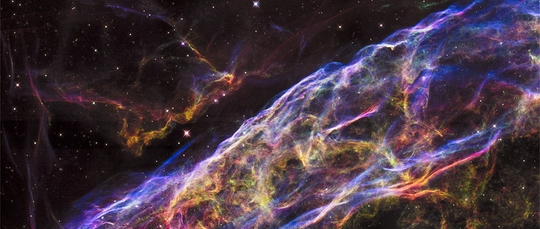My primary research interests pertain to improving the cosmic distance scale and characterizing the interstellar medium. That helps foster determinations of the expansion rate of the Universe, and facilitates efforts to delineate the spiral structure of the Milky Way and constrain astrochemistry (e.g., celestial molecules). I conduct research in part as a member of ESO's VVV Survey and SMU/MSVU, while helping run a college astronomy program abroad (WCC). Regarding the Galaxy, maps of its spiral structure are uncertain and exhibit striking differences. Indeed, some 150+ years after Alexander suggested the Milky Way was spiral in nature there lacks consensus on its morphology (e.g., number of spiral arms, central bar(s)). Certain research indicates that perfect spiral patterns ineptly describe features near the Sun, and the possible scenario of the Sun residing within a spur implies that such features are not unique. Our work on the astronomical distance scale likewise aims to provide improved distances to galaxies and star clusters, such as the famed Pleiades and Andrews-Lindsay 1 (also known as ESO 96-4 and VdBH 144). Andrews-Lindsay 1 is a rare open cluster granted it hosts a planetary nebula, designated PHR J1315-6555 or PN G305.3-03.1 (Parker et al. 2006 & 2011, Majaess et al. 2007 & 2014, Frew 2008). The planetary nebula phase is a later evolutionary stage for stars exhibiting a mass approximately 1-8 times that of the Sun, and thus provides a tantalizing glimpse into the Sun's future.
For example, the cosmic distance scale can be anchored in part via deep near-infrared main-sequence fits to star clusters (e.g., Majaess et al. 2011), and thereafter applied to those clusters hosting a class of pulsating stars designated classical Cepheids (see Turner 2012). The scale can be tied to numerous open clusters exhibiting matching near-infrared and revised Hipparcos distances (the Hyades, α Per, Praesepe, Coma Ber, IC 2391, IC 2609, and NGC 2451). An objective is to avoid deriving distances to Cepheid-hosting clusters using a discrepant benchmark (e.g., the Pleiades and Blanco 1), namely to avoid propagating ambiguity into a Cepheid calibration employed to characterize the Universe's expansion. The revised Hipparcos parallax for the Pleiades star cluster implied a distance of 120.2±1.9 pc, whereas the near-infrared analysis yielded a further distance of 138±6 pc. The latter result was recently supported by the Gaia parallax mission, although incessant vetting is likewise required for that space probe. The multi-cluster near-infrared approach was applied to determine distances to various clusters, such as the (dissolving) one hosting Delta Cephei (de Zeeuw et al. 1999, Turner & Burke 2002, Majaess et al. 2012), which is the namesake for the class of Cepheid stars. Interestingly, Fragkou et al. 2019 recently discovered that the planetary nebula BMP J1613-5406 is a member of the star cluster NGC 6067, which also hosts two Cepheids (e.g., Coulson & Caldwell 1985, Majaess et al. 2013), thereby providing a lucrative opportunity to constrain stellar evolution. Additional information on Cepheids in star clusters can be found at astronomer David Turner's website, and for a comprehensive review on the broader topic of Cepheids see Turner 2012.
Below is an abbreviated list of published work carried out in concert with a team of research collaborators, and a more comprehensive listing of our work is indexed in NASA's astrophysics data system, ResearchGate, Google Scholar, and ORCID.
- Majaess, D.; Harriott, T.; Seuret, H.; Morera-Boado, C.; Massa, L.; Matta, C., 2025, The Critical 9365 Å Diffuse Interstellar Band and C60+ Association, Research Notes of the American Astronomical Society, 9, 9 (HTML, PDF)
- Seuret, H.; Sullivan, A. D.; Morera-Boado, C.; Harriott, T. A.; Majaess, D.; Massa, L.; Matta, C., 2025, Vetting molecular candidates posited for the first diffuse interstellar bands (5780 and 5797 Å): a quantum chemical study, Physical Chemistry Chemical Physics, in press (HTML, PDF)
- Majaess, D.; Seuret, H.; Harriott, T.; Morera-Boado, C.; Sullivan, A. D.; Massa, L.; Matta, C., 2025, Potential Vibrational Modes Tied to Diffuse Interstellar Bands, Monthly Notices of the Royal Astronomical Society, 539, 4 (HTML, PDF)
- Majaess, D.; Harriott, T.; Seuret, H.; Morera-Boado, C.; Massa, L.; Matta, C., 2025, Strengthening the Link Between Fullerenes and a Subset of Diffuse Interstellar Bands, Monthly Notices of the Royal Astronomical Society, 538, 4 (HTML, PDF)
- Majaess, D.; Bonatto, C.; Turner, D.; Saito, R.; Minniti, D.; Moni Bidin, C.; González-Díaz, D.; Alonso-Garcia, J.; Bono, G.; Braga, V.; Navarro, M.; Carraro, G.; Gomez, M., 2025, The Gaia parallax discrepancy for the cluster Pismis 19, and separating δ Scutis from Cepheids, The Astrophysical Journal, 982, 2 (HTML, PDF)
- Alonso-García, J.; Smith, L.; Sanders, J.; Minniti, D.; Catelan, M.; Aravena Rojas, G.; Carballo-Bello, J.; Fernández-Trincado, J.; Ferreira Lopes, C.; Garro, E.; Guo, Z.; Hempel, M.; Lucas, P.; Majaess, D.; Saito, R.; Vivas, A., 2025, Variable stars in the VVV globular clusters III. RR Lyrae stars in the inner Galactic globular clusters, Astronomy & Astrophysics, 695 (HTML, PDF)
- Majaess D., Turner D. G., Usenko I., 2024, A Rare Cepheid-hosting Open Cluster Triad in Sagittarius, Research Notes of the American Astronomical Society, 8, 205 (HTML, PDF)
- Majaess D., Turner D., Minniti D., Alonso-Garcia J., Saito R. K., 2024, The Valuable Long-period Cluster Cepheid KQ Scorpii and other Calibration Candidates, Publications of the Astronomical Society of the Pacific, 136, 9 (HTML, PDF)
- Saito R., Hempel M., Alonso-García J., Lucas P. W., Minniti D., Alonso S., Baravalle L., Borissova J., Caceres C., Chené A. N., Cross N., Duplancic F., Garro E., Gómez M., Ivanov V. D., Kurtev R., Luna A., Majaess D., Navarro M., Pullen J., et al., 2024, The VISTA Variables in the Vía Láctea eXtended (VVVX) ESO public survey: Completion of the observations and legacy, Astronomy & Astrophysics, 689, id.A148 (PDF)
- Majaess D., Turner D. G., 2024, A suite of classical Cepheids tied to the binary cluster Berkeley 58 & NGC 7790, Publications of the Astronomical Society of the Pacific, 136, 6 (HTML, PDF)
- Majaess D., 2024, Concerning SH0ES data: discrepant W_0,VI absolute magnitudes for Cepheids in the keystone galaxy NGC4258, Monthly Notices of the Royal Astronomical Society, 529, 3 (HTML, PDF)
- Xing H., Sullivan A., Seuret H., Morera-Boado C., Harriott T., Majaess D., Massa L., Matta C., 2024, Extinction along Sightlines Sampled by the APO Catalog of DIBs, Research Notes of the AAS, 8, 3. (HTML, PDF)
- Majaess, D., 2024, The Concerning SH0ES Hubble Constant, VVVX Survey conference, hosted at the Vatican Observatory, Castel Gandolfo. (PDF, ResearchGate)
- Griv, E.; Jiang, I.; Majaess, D.; Minniti, D., 2023, Statistical determination of the distance to the Galactic Centre and the outset of the Milky Way old bulge: astrophysical conclusions, Astrophysics & Space Science, 368, 80.
- Usenko, I. A.; Miroshnichenko, A. S.; Danford, S.; Turner, D. G.; Majaess, D. J.; Balam, D. D., 2023, Spectroscopic Investigations of Polaris Field Stars, Odessa Astronomical Publications, 36.
- Smith, Emily R.; Smith, Fraser M.; Harriott, Tina A.; Majaess, Daniel; Massa, Lou; Matta, Chérif F., 2022, Novel Correlations between Diffuse Interstellar Bands and Optical Reddening, Research Notes of the AAS, 6, 4. (PDF, ResearchGate)
- Paladini, R.; Zucker, C.; Benjamin, R.; Nataf, D.; Minniti, D.; Zasowski, G.; Peek, J.; Carey, S.; Allen, L.; Alonso-Garcia, J.; Alves, J.; Anders, F.; Athanassoula, E.; Beers, T.; Bird, J.; Bland-Hwathorn, J.; Brown, A.; Buder, S.; Casagrande, L.; Casey, A.; Cassisi, S.; Catelan, M.; Chary, R.; Chene, A.; Ciardi, D.; Comeron, F.; Cohen, R.; Dame, T.; Drimmel, R.; Fernandez Trincado, J.; Finkbeiner, D.; Geisler, D.; Gennaro, M.; Goodman, A.; Green, G.; Hajdu, G.; Henderson, C.; Hora, J.; Ivanov, V.; Kirkpatrick, D.; Kobayashi, C.; Kuhn, M.; Kunder, A.; Lu, J.; Lucas, P.; Majaess, D.; Megeath, S.; Meisner, A.; Molinari, S.; Mroz, P.; Ness, M.; Neumayer, N.; Nogueras-Lara, F.; Noriega-Crespo, A.; Poleski, R.; Rix, H.; Rebull, L.; Reggiani, H.; Rejkuba, M.; Saito, R.; Schoenrich, R.; Saydjari, A.; Schisano, E.; Schlafly, E.; Schlaufman, K.; Smith, L.; Speagle, J.; Wisz, D.; Wyse, R.; Zakamska, N., 2021, Roman Early-Definition Astrophysics Survey Opportunity: Galactic Roman Infrared Plane Survey (GRIPS), White Paper on early-definition astrophysics opportunity (PDF)
- Smith, Fraser M.; Harriott, Tina A.; Majaess, Daniel; Massa, Lou; Matta, Chérif F., 2021, Establishing new diffuse interstellar band correlations to identify common carriers, Monthly Notices of the Royal Astronomical Society, 507, 4 (PDF)
- Griv, Evgeny; Gedalin, Michael; Pietrukowicz, Pawel; Majaess, Daniel; Jiang, Ing-Guey, 2021, The Sun's distance from the Galactic Centre and mid-plane, and the Galactic old bulge's morphology: 715 VVV Type II Cepheids, Monthly Notices of the Royal Astronomical Society, 502, 3. (PDF)
- Minniti, D.; Ripepi, V.; Fernández-Trincado, J. G.; Alonso-García, J.; Smith, L. C.; Lucas, P. W.; Gómez, M.; Pullen, J. B.; Garro, E. R.; Vivanco Cádiz, F.; Hempel, M.; Rejkuba, M.; Saito, R. K.; Palma, T.; Clariá, J. J.; Gregg, M.; Majaess, D., 2021, Discovery of new globular clusters in the Sagittarius dwarf galaxy, Astronomy & Astrophysics, 647, L4. (PDF)
- Navarro M.; Minniti D.; Capuzzo-Dolcetta R.; Alonso-Garcia J.; Contreras Ramos R.; Majaess D.; Ripepi V., 2021, The RR Lyrae projected density distribution from the Galactic centre to the halo, Astronomy & Astrophysics, 646, A45. (PDF)
- Garro E., Minniti D., Gomez M., Alonso-Garcia J., Barba R., Barbuy B., Claria J., Chene A., Dias B., Hempel M., Ivanov V., Lucas P., Majaess D., Mauro F., Moni Bidin C., Palma T., Pullen J., Saito R., Smith L., Surot F., Ramirez Alegria S., Rejkuba M., Ripepi V., 2020, VVVX-Gaia Discovery of a Low Luminosity Globular Cluster in the Milky Way Disk, Astronomy & Astrophysics, 642, L19. (PDF)
- Griv E., Gedalin M., Pietrukowicz P., Majaess D., Jiang I., 2020, The distance from the Sun to the center and the shape of the old bulge in the Galaxy: 16 221 OGLE RR Lyrae stars, Monthly Notices of the Royal Astronomical Society, 499, 1. (PDF)
- Majaess D., 2020, On the Paradoxical Impact of Blending by Red Clump Giants, the Astrophysical Journal, 891, 1. (PDF)
- Soto M., Barba R., Minniti D., Kunder, A., Majaess D., Nilo-Castellon J. L., Alonso-Garcia J., Leone G., Morelli L., Haikala L., Firpo V., Lucas P., Emerson J. P., Moni Bidin C., Geisler D., Saito R. K., Gurovich S., Contreras Ramos R., Rejkuba M., Barbieri M., Roman-Lopes A., Hempel M., Alonso M. V., Baravalle L. D., Borissova J., Kurtev R., Milla F., 2019, A colour-excess extinction map of the southern Galactic disc from the VVV and GLIMPSE surveys, Monthly Notices of the Royal Astronomical Society, 488, 2. (PDF)
- Gonzalez-Diaz D., Moni Bidin C., Silva-Villa E., Carraro G., Majaess D., Moitinho A., Orquera-Rojas C., Morales Marin C. A. L., Morales-Campana E., 2019, Solving the distance discrepancy for the open cluster NGC 2453. The planetary nebula NGC 2452 is not a cluster member, Astronomy & Astrophysics, 626, 10. (PDF)
- Majaess D., Dekany I., Hajdu G., Minniti D., Turner D., Gieren G., 2018, Establishing the Galactic Centre Distance Using VVV Bulge RR Lyrae Variables, Astrophysics & Space Science, 363, 6. (PDF | CDS catalog)
- Dekany I., Hajdu G., Grebel E., Catelan M., Elorrieta F., Eyheramendy S., Majaess D., Jordan A., 2018, Near-IR RR Lyrae census along the southern plane: the Milky Way's stellar fossil brought to light, Astrophysical Journal, 857, 1. (PDF | CDS catalog)
- Minniti D., Saito R., Gonzalez O., Alonso-Garcia J., Rejkuba M., Barba R., Irwin M., Kammers R., Lucas P., Majaess D., Valenti E., 2018, A new near-IR low-extinction window in the Galactic Plane, Astronomy & Astrophysics, 571. (PDF)
- Minniti, D.; Saito, R. K.; Forster, F.; Pignata, G.; Ivanov, V. D.; Lucas, P. W.; Beamin, J. C.; Borissova, J.; Catelan, M.; Gonzalez, O. A.; Hempel, M.; Hsiao, E.; Kurtev, R.; Majaess, D.; Masetti, N.; Morrell, N. I.; Phillips, M. M.; Pullen, J. B. ; Rejkuba, M.; Smith, L. ; Surot, F. ; Valenti, E.; Zoccali, M., 2017, The Emergence of the Infrared Transient VVV-WIT-06, The Astrophysical Journal Letters, Volume 849, Issue 2, id. L23. (PDF)
- Minniti, D., Dekany, I., Majaess, D., Palma, T., Pullen, J., Rejkuba, M., Alonso-García, J., Catelan, M., Contreras Ramos, R., Gonzalez, O., Hempel, M., Irwin, M., Lucas, P., Saito, R., Tissera, P., Valenti, E., Zoccali, M., 2017, Characterization of the VVV Survey RR Lyrae Population across the Southern Galactic Plane, Astronomical Journal, 153, 4. (PDF | CDS catalog)
- Carraro, G., Turner, D., Majaess, D., Baume, G., Gamen, R., Molina Lera, J., 2017, Extinction in the Star Cluster SAI 113 and Galactic Structure in Carina, Astronomical Journal, 153, 4. (PDF)
- Minniti, D., Palma, T., Dekany, I., Hempel, M., Rejkuba, M., Pullen, J., Alonso-Garcia, J., Barbá, R., Barbuy, B., Bica, E., Bonatto, C., Borissova, J., Catelan, M., Carballo-Bello, J., Chene, A., José Clariá, J., Cohen, R., Contreras Ramos, R., Dias, B., Emerson, J., Froebrich, D., Buckner, A., Geisler, D., Gonzalez, O., Gran, F., Hagdu, G., Irwin, M., Ivanov, V., Kurtev, R., Lucas, P., Majaess, D., Mauro, F., Moni-Bidin, C., Navarrete, C., Ramírez Alegría, S., Saito, R., Valenti, E., Zoccali, M., 2017, FSR 1716: A New Milky Way Globular Cluster Confirmed Using VVV RR Lyrae Stars, Astrophysical Journal Letters, 838, 1. (PDF)
- Majaess, D.; Turner, D.; Dekany, I.; Minniti, D.; Gieren, W., 2016, Constraining dust extinction properties via the VVV Survey, Astronomy & Astrophysics, 593. (PDF)
- Dekany, I.; Minniti, D.; Majaess, D.; Zoccali, M.; Hajdu, G.; Alonso-Garcia, J.; Catelan, M.; Gieren, W.; Borissova, J., 2015, The VVV Survey Reveals Classical Cepheids Tracing a Young and Thin Stellar Disk across the Galaxy's Bulge, Astrophysical Journal Letters, 812, 2. (PDF)
- Dambis, A. K.; Berdnikov, L. N.; Efremov, Yu. N.; Kniazev, A. Yu.; Rastorguev, A. S.; Glushkova, E. V.; Kravtsov, V. V.; Turner, D. G.; Majaess, D. J.; Sefako, R., 2015, Classical Cepheids and the spiral structure of the Milky Way, Astronomy Letters, 41, 9. (PDF)
- Dekany, I., Minniti, D., Hajdu, G., Alonso-Garc, J., Hempel, M.,Palma, T., Catelan, M., Gieren, W., Majaess, D., 2015, Discovery of a Pair of Classical Cepheids in an Invisible Cluster Beyond the Galactic Bulge, Astrophysical Journal Letters, 799, 1. (PDF)
- Majaess, D., Turner, D., Gieren, W., Ngeow, C., 2014, Evidence for Photometric Contamination in Key Observations of Cepheids in the Benchmark Galaxy IC 1613, Astronomy & Astrophysics, 572. (PDF)
- Borissova, J., Chene A.-N., Ramez Alegr, S., Sharma, S., Clarke, J. R. A., Kurtev, R., Negueruela, I., Marco, A., Amigo, P., Minniti, D., Bica, E., Bonatto, C., Catelan, M., Fierro, C., Geisler, D., Gromadzki, M., Hempel, M., Hanson, M. M., Ivanov, V. D., Lucas, P., Majaess, D., Moni Bidin, C., Popescu, B., Saito, R. K., 2014, New galactic star clusters discovered in the VVV survey. Candidates projected on the inner disk and bulge, Astronomy & Astrophysics, 569. (PDF)
- Majaess, D., Carraro, G., Moni Bidin, C., Bonatto, C., Turner, D., Moyano, M., Berdnikov, L., Giorgi, E., 2014, On the crucial cluster Andrews-Lindsay 1 and a 4% distance solution for its planetary nebula, Astronomy & Astrophysics, 567. (PDF | CDS catalog)
- Turner, D.,Majaess, D., Balam, D., 2014, Testing New Ideas Regarding the Nature of Interstellar Extinction, Canadian Journal of Physics, 92, 12. (PDF)
- Berdnikov, L. N., Majaess, D., 2014, Search for evolutionary changes in the periods of Cepheids: U Sgr, Astronomy Letters, 40. (PDF | CDS catalog)
- Moni Bidin, C., Majaess, D., Bonatto, C., Mauro, F., Turner, D., Geisler, D., Chene A.-N., Gormaz-Matamala, A. C., Borissova, J., Kurtev, R. G., Minniti, D., Carraro, G., Gieren, W., 2014, Investigating potential planetary nebula/cluster pairs, Astronomy & Astrophysics, 561. (PDF | CDS catalog)
- Majaess, D., Carraro, G., Moni Bidin, C., Bonatto, C., Berdnikov, L., Balam, D., Moyano, M., Gallo, L., Turner, D., Lane, D., Gieren, W., Borissova, J., Kovtyukh, V., Beletsky, Y., 2013, Anchors for the cosmic distance scale: the Cepheids U Sagittarii, CF Cassiopeiae, and CEab Cassiopeiae, Astronomy & Astrophysics, 560. (PDF)
- Rosvick, J., Majaess, D., 2013, Star Formation near Berkeley 59: Embedded Protostars, Astrophysical Journal, 146. (PDF)
- Carraro, G.; Turner, D.; Majaess, D.; Baume, G., 2013, The distance to the young open cluster Westerlund 2, Astronomy & Astrophysics, Volume 555, id. A50. (PDF | CDS catalog)
- Majaess, D., Turner, D., Gieren, W., 2013, On the Form of the Spitzer Leavitt Law and its Dependence on Metallicity, Astrophysical Journal, 772, 2. (PDF)
- Majaess, D., Sturch, L., Moni Bidin, C., Soto, M., Gieren, W., Cohen, R., Mauro, F., Geisler, D., Bonatto, C., Borissova, J., Minniti, D., Turner, D., Lane, D., Madore, B., Carraro, G., Berdnikov, L., 2013, Anchors for the Cosmic Distance Scale: the Cepheid QZ Normae in the Open Cluster NGC 6067, Astrophysics and Space Science, 347, 1. (PDF)
- Majaess, D., 2013, Discovering Protostars and their Host Clusters via WISE, Astrophysics & Space Science, 344, 1. (PDF | CDS catalog)
- Chene A.-N., Borissova, J., Bonatto, C., Majaess, D., Baume, G., Clarke, J., Kurtev, R., Schnurr, O., Bouret, J.-C., Catelan, M.,+ 13 coauthors, 2013, Massive open star clusters using the VVV survey. II. Discovery of six clusters with Wolf-Rayet stars, Astronomy & Astrophysics, 549. (PDF)
- Majaess, D., Turner, D., Gieren, W., Berdnikov, L., Lane, D., 2013, On the metallicity dependence of classical Cepheid light amplitudes, Astrophysics & Space Science, 344, 2. (PDF)
- Majaess, D., Turner, D., Gallo, L., Gieren, W., Bonatto, C., Lane, D., Balam, D., Berdnikov, L., 2012, Anchoring the Distance Scale via X-ray/Infrared Data for Cepheid Clusters: SU Cas, Astrophysical Journal, 753, 2. (PDF)
- Majaess, D.; Turner, D.; Gieren, W., 2012, Identifying Contaminated K-Band Globular Cluster RR Lyrae Photometry, Publications of the Astronomical Society of Pacific, 124, 920. (PDF)
- Majaess, D., Turner, D., Gieren, W., Balam, D., Lane, D., 2012, Discovery of the Host Cluster for the Fundamental Cepheid Calibrator Zeta Geminorum, Astrophysical Journal Letters, 748, 1. (PDF)
- Turner, D. G.; van den Bergh, S.; Younger, P. F.; Majaess, D. J.; Pedreros, M. H.; Berdnikov, L. N., 2012, A Search for OB Associations near Southern Long-period Cepheids. V. AQ Puppis and V620 Puppis, The Astronomical Journal, Volume 144, Issue 6, id. 187. (PDF | CDS catalog )
- Majaess, D., Turner, D., Gieren, W., Lane, D., 2012, The Impact of Contaminated RR Lyrae/Globular Cluster Photometry on the Distance Scale, Astrophysical Journal Letters, 752, 1. (PDF)
- Majaess, D., Turner, D., Gieren, W., 2012, A Cluster of Class I/f/II Young Stellar Objects Discovered near the Cepheid SU Cas, Monthly Notices of the Royal Astronomical Society, 421, 2. (PDF)
- Majaess, D., Turner, D., Moni Bidin, C., Geisler, D., Borissova, J., Minniti, D., Bonatto, C., Gieren, W., Carraro, G., Kurtev, R., Mauro, F., Chene A.-N., Forbes, D., Lucas, P., Dekany, I., Saito, R. K., Soto, M., 2012, Strengthening the Open Cluster Distance Scale via VVV photometry, Astronomy & Astrophysics Letters, 537. (PDF)
- Majaess, D., Turner, D., Gieren, W., 2012, New Evidence Supporting Cluster Membership for the Keystone Calibrator Delta Cephei, Astrophysical Journal, 747, 2. (PDF)
- Chene A.-N.; Borissova, J.; Clarke, J. R. A.; Bonatto, C.; Majaess, D. J.; Moni Bidin, C.; Sale, S. E.; Mauro, F.; Kurtev, R.; Baume, G.; Feinstein, C.; Ivanov, V. D.; Geisler, D.; Catelan, M.; Minniti, D.; Lucas, P.; de Grijs, R.; Kumar, M. S. N., 2012, Massive open star clusters using the VVV survey. I. Presentation of the data and description of the approach, Astronomy & Astrophysics, 545. (PDF | CDS catalog)
- Saito, R., +100 coauthors, incl. Majaess, D., 2012, VVV DR1: The first data release of the Milky Way bulge and southern plane from the near-infrared ESO public survey VISTA variables in the Via Lactea, Astronomy & Astrophysics, 537. (PDF | CDS catalog)
- Turner, D. G.; Majaess, D. J.; Lane, D. J.; Balam, D. D.; Gieren, W. P.; Storm, J.; Forbes, D. W.; Havlen, R. J.; Alessi, B., 2012, Alessi 95 and the short-period Cepheid SU Cassiopeiae, MNRAS, Vol. 222, Issue 3. (PDF)
- Majaess, D., Turner, D., Gieren, W., 2011, Concerning the Classical Cepheid VIc Wesenheit Function's Strong Metallicity Dependence, Astrophysical Journal Letters, 741, 2. (PDF)
- Majaess, D., Turner, D., Moni Bidin, C., Mauro, F., Geisler, D., Gieren, W., Minniti, D., Chene, A-N., Lucas, P., Borissova, J., Kurtev, R., Dekany, I., Saito, R., 2011, New Evidence Supporting Membership for TW Nor in Lynga 6 and the Centaurus Spiral Arm, Astrophysical Journal Letters, 741, 2. (PDF)
- Turner, D., Rosvick, J., Balam, D., Henden, A., Majaess, D., Lane, D., 2011. New Results for the Open Cluster Bica 6 and its Associated Planetary Nebula Abell 8, Publications of the Astronomical Society of the Pacific, 123, 909. (PDF)
- Majaess, D., Turner, D., Lane, D., Krajci, T., 2011, Deep Infrared ZAMS Fits to Benchmark Open Clusters Hosting Delta Scutis, Journal of the American Association of Variable Star Observers, 39, 2. (PDF)
- Majaess, D., Turner, D., Lane, D., Henden, A., Krajci, T., 2011, Anchoring the Universal Distance Scale Via a Wesenheit Template, Journal of the American Association of Variable Star Observers, 39, 1. (PDF)
- Majaess, D., 2010, The Cepheids of Centaurus A (NGC 5128) and the Implications for Ho, Acta Astronomica, 60. (PDF)
- Majaess, D., 2010, RR Lyrae and Type II Cepheids Adhere to a Common Distance Relation, Journal of the American Association of Variable Star Observers, 38, 1. (PDF)
- Majaess, D., 2010, Concerning the Distance to the Center of the Milky Way and its Structure, Acta Astronomica, 60. (PDF)
- Majaess, D., Turner, D., Lane, D., 2009, Searching Beyond the Obscuring Dust of the Cygnus-Aquila Rifts for Cepheid Tracers of the Galaxy's Spiral Arms, Journal of the American Association of Variable Star Observers, 37, 2. (PDF)
- Majaess, D., Turner, D., Lane, D., 2009, Type II Cepheids as Extragalactic Distance Candles, Acta Astronomica, 59. (PDF)
- Majaess, D., Turner, D., Lane, D., 2009, Characteristics of the Galaxy According to Cepheids, Monthly Notices of the Royal Astronomical Society, 398, 1. (PDF)
- Turner, D., Forbes, D., Leonard, P., Abdel-Latif, M., Majaess, D., Berdnikov, L., 2009, Does Collinder 236 Host a Cepheid Calibrator?, Monthly Notices of the Royal Astronomical Society, 397, 2. (PDF)
- Turner, D., Kovtyukh, V., Majaess, D., Lane, D., Moncrieff, K. 2009, The Cepheid Impostor HD 18391 and its Anonymous Parent Cluster, Astronomische Nachrichten, 330, 8. (PDF)
- Majaess, D., Higgins, D., Molnar, L., Haegert, M., Lane, D., Turner, D., Nielsen, I., 2009, New Constraints on the Asteroid 298 Baptistina, the Alleged Family Member of the K/T Impactor, Journal of the Royal Astronomical Society of Canada, 103, 1. (PDF)
- Berdnikov, L., Pastukhova, E., Turner, D., Majaess, D., 2009, Search for Evolutionary Changes in Cepheid Periods Using the Harvard Plate Collection. NSV 9159, Astronomy Letters, 35, 3. (PDF | CDS catalog)
- Majaess, D., Turner, D., Lane, D., 2008, Assessing Potential Cluster Cepheids from a New Reddening-free Parameterization and 2MASS Photometry, Monthly Notices of the Royal Astronomical Society, 390, 4. (PDF)
- Majaess, D., Tanner, J., Savoy, J., Sampson, B. 2008, 349 Dembowska: A Minor Study of its Shape and Parameters, Minor Planet Bulletin, 35, 2. (PDF)
- Turner, D., Panko, E., Sergienko, O., Lane, D., Majaess, D. 2008, New Insights into the Nature of the Eclipsing System V609 Aquilae, The Observatory, 128. (PDF)
- Majaess, D., Turner, D., Lane, D., Moncrieff, K., 2008, The Exciting Star of the B59/Cepheus OB4 Complex and Variable Star Discoveries, Journal of the American Association of Variable Star Observers, 36, 1. (PDF)
- Majaess, D., Turner, D., Lane, D., 2007, In Search of Possible Associations between Planetary Nebulae and Open Clusters, Publications of the Astronomical Society of the Pacific, 119, 862. (PDF)
- Turner, D., +17 coauthors, Majaess, D., 2007, The Period Changes of the Cepheid RT Aurigae, Publications of the Astronomical Society of the Pacific, 119, 861. (PDF)
- [...]
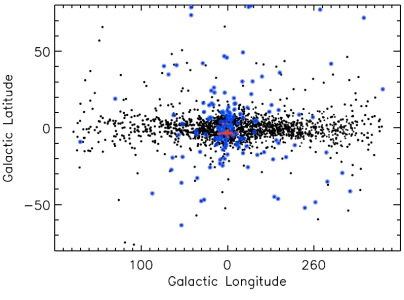
A view of the Galaxy as traced by planetary nebulae (black dots) and globular clusters (blue dots), from Figure 1 in Majaess 2010.
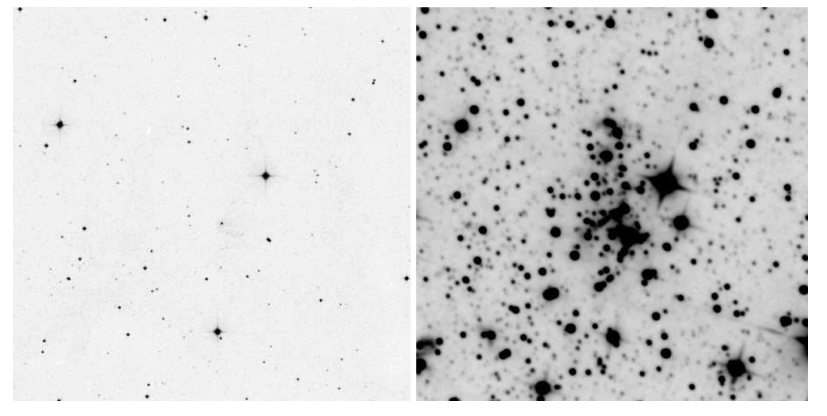
Figure 1 from Majaess et al. 2012, who investigated a new star cluster at coordinates J2000 02:54:31.4 +69:20:32.5 which is absent in optical light (left panel) owing to significant obscuring dust, but is apparent in a mid-infrared image from NASA's Wide-field Infrared Survey Explorer (right panel, ~3.4 microns). Numerous class I young stellar objects were discovered using WISE data, and the host star cluster was also cataloged as object 230 in Majaess 2013. Indeed, Issac et al. 2020 subsequently hypothesized that the cluster emerged from the collision of interstellar clouds (see their Figure 10), and is linked to an adjacent longer-wavelength Planck cold clump source (G133.50+9.01).
Below are articles contributed to the Universe Today astronomy e-magazine for a broad audience, and they are less formal than the academic publications above:
- New System Discovered with Five Planets, July 1, 2016.
- Radio waves absent from the reputed megastructure-encompassed Kepler star?, November 9, 2015.
- Astronomers bypass visible light to map the Galaxy's structure, May 11, 2015.
- Lopsided Supernovae could be Responsible for Rogue Hypervelocity Stars, February 10, 2015.
- Searching for Alien Worlds and Gravitational Lenses from the Arctic, November 24, 2014.
- A Splash of Color Across the Supermoon, September 24, 2014.
- Too WISE to be Fooled by Dust: Over 300 New Star Clusters Discovered, June 11, 2014.
- Young Boy's Discovery Confirmed as a Peculiar Supernova Explosion, December 10, 2013.
- 10-Year-Old Boy Discovers a 600 Million Year-Old Supernova, November 1, 2013.
- Characterizing the Population of Nearby Potential Earth Impactors, October 14, 2013.
- Citizen Scientists Hunt for Impact Craters in Persia, July 15, 2013.
- Astronomers Refine Distances to our Closest Spiral Galaxy Neighbors, June 10, 2013.
- Dust Complicates Determinations of the Distance to Galactic Center, April 25, 2013.
- Astronomers Hint that our Sun wont Terminate as the Typical Planetary Nebula, April 18, 2013.
- Are Textbooks Wrong? Astronomers Clash Over Hubble's Legacy, April 4, 2013.
- Kepler Team Identifies Planet Impostors that are Binary Stars in Disguise, March 16, 2013.
- Russian Asteroid Explosion and Past Impactors Paint a Potentially Grim Future for Earth, March 7, 2013.
- Spock Weighs in on President Obama’s ‘Meld-Gate’, March 3, 2013.
- Nearby Ancient Star is Almost as Old as the Universe, February 23, 2013.
- Narrowing Down the Hunt for Giant Exoplanets, February 19, 2013.
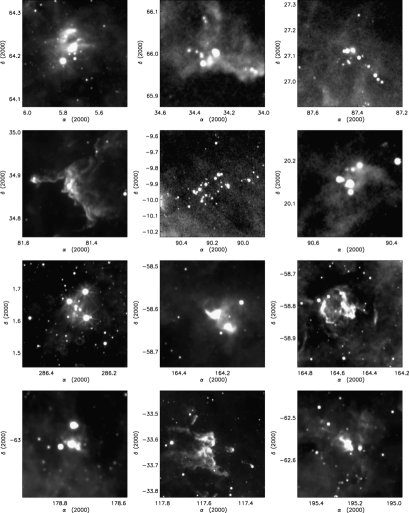
Figure 2 in Majaess 2013 highlights a subset of the (sub)clusters replete with protostars.
Curious students stumble across various star clusters, and desire additional information. They were for the most part identified as younger embedded (sub)clusters in the work designated Discovering protostars and their host clusters via WISE (the digitized CDS catalog is here), which relied largely on observations from NASA's WISE spacecraft. Essentially a first-order hybrid near and mid-infrared relation (JHKs-W1W2W3W4) was constructed to identify (sub)clusters replete with class I/f protostars. Such targets can possess diverse designations say when surveyed in separate portions of the electromagnetic spectrum, and (inevitably) cross-matched upon subsequent dedicated investigations adopting a holistic multiwavelength examination. For example, Mohr-Smith et al. 2017 examined the region surrounding the extreme O-supergiant LSS 2063, and they noted, "Dutra et al. 2003 did catalogue an NIR cluster essentially coincident with LSS 2063 and, more recently, Majaess 2013 has noted this location as a plausible clustering of young stars based on raised mid-IR emission (Majaess 133, in the associated catalogue). ... Avedisova 2002, in her list of star-forming regions, also notes a coincidence between radio emission in this location and RAFGL 4120 (an earlier mid-IR detection effectively). So here, finally, the optical has caught up and the very much larger group of ionizing stars, helping LSS 2063 shape this environment, has emerged." Maiz-Apellaniz et al. 2020 returned to this intriguing region and noted, "Villafranca O-006 = Gum 35 = Majaess 133 ... This is the most overlooked object in our sample, with only a few significant references in the literature. ... It is close to NGC 3603 in position in the sky (2 deg away) and extinction (Av~5), and the two distance error bars overlap, so it is possible the two objects are physically associated, as suggested by Mohr-Smith et al. 2017." Camargo et al. 2015 & 2016 surveyed Majaess 24 and substructure therein, 30, 45, and 78. Regarding the latter, Camargo et al. 2015 conveyed that, "Majaess 78: our analyses suggest that this embedded cluster lies in the Perseus spiral arm at a distance of 3.2±0.5 kpc and presents an age of approximately 3 Myr (million years)." Issac et al. 2020 hypothesized that the newly formed star cluster identified by Majaess et al. 2012 using mid-infrared WISE data at coordinates J2000 02:54:31.4 +69:20:32.5 emerged from "a bona fide cloud-cloud collision" (see their Figure 10). That cluster hosts numerous class I young stellar objects (YSOs), and was also cataloged as object 230 in Majaess 2013. An image displayed above conveys the region sampled in the optical portion of the electromagnetic spectrum, and the mid-infrared WISE image (~3.4 microns). The cluster is absent in the optical owing to sizable extinction by interstellar dust, and Issac et al. 2020 connected it to a proximal longer-wavelength Planck cold clump source (G133.50+9.01). Chen et al. 2016 hinted that the pulsating star ASASJ160125-5150.3 (a Cepheid) could be a member of Majaess 170, and they noted, "Majaess 170 is a small open cluster with a size of 5' (Dias et al. 2002). ASAS J160125−5150.3 is located 7' from the cluster centre. This cluster has not been studied previously. The distance modulus, colour excess, and age we determined are μ0=11.30±0.28 mag (d=1.8±0.3 kpc), E(J-H)=0.38±0.03 mag, and log(t)=8.1±0.2, respectively. ... The Cepheid’s proper-motion and distance-modulus measurements imply that it is a high-probability cluster member. The age of ASAS J160125−5150.3, derived from its period, is approximately log(t)=7.8±0.1, which implies a difference with respect to the host cluster of less than 0.3 dex." An alternate possibility to consider is that the cluster (Majaess 170) is significantly younger than the Cepheid (ASAS J160125−5150.3), which would negate a connection, and further research is desirable. Below is an image compiled by Ferreira et al. 2019 of the broader field hosting NGC5999 and Majaess 166 (see their Figure 3), and they indicated that, "Majaess 166 was identified as a very young cluster with a size of 4' (Majaess 2013), and it is easily distinguished from UFMG 3 in DSS images for its nebulous nature, the cluster being still embedded in the progenitor gas cloud. Being probably distant clusters projected in the direction of UFMG 3, Teutsch 81, and Majaess 166 could be better investigated using near-infrared bands, possibly allowing their stellar content to be distinguished from field stars."
Diverse researchers are mobilizing to advance humanity's celestial knowledge in a pyramid-like fashion, each adding a block in a broad collaboration.
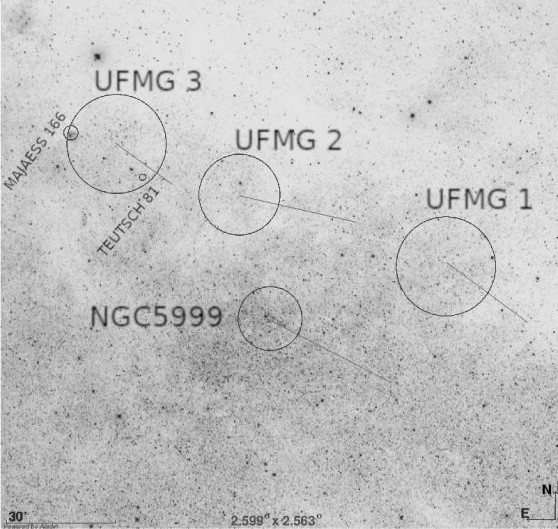
Figure 3 from Ferreira et al. 2019 displaying NGC5999, Majaess 166, and other star clusters (see also T. Nowakowski's phys.org article on the broader Ferreira et al. 2019 results).
Lastly, curious students likewise often stumble upon astronomer David Balam's discovery of the main-belt asteroid 304233 Majaess, and inquire about the object. The asteroid exhibits a slightly inclined orbit as shown below (i~12.6 deg), and lies in the main asteroid belt between Mars and Jupiter. The full suite of parameters for the asteroid can be viewed at NASA's JPL Small-body Database Browser, and it adheres to an average distance of 2.9 AU and features an orbital period of 4.8 years. The asteroids linked to my former graduate supervisors are 27810 Daveturner and 117032 Davidlane. Warner et al. 2011 concluded that, "the Hungaria asteroid 27810 Daveturner ... (has a) synodic rotation period of P = 540 ± 20 h".
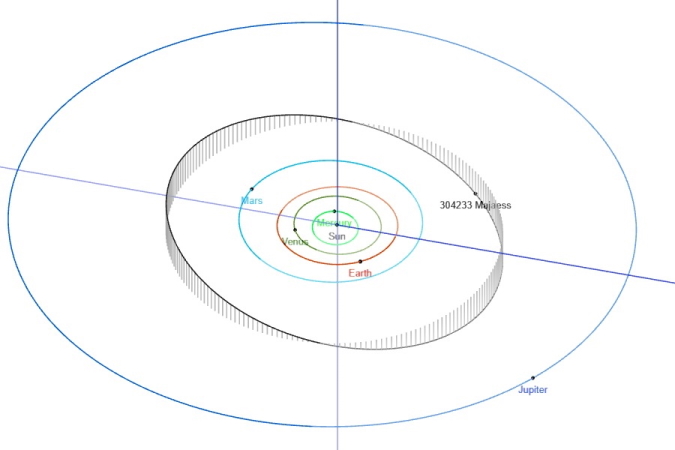
Orbit of main-belt asteroid 304233 Majaess from NASA's JPL Small-body Database Browser, and it features orbital parameters of a~2.9 AU, i~12.6 deg, and P~4.8 years. The asteroid was discovered by astronomer David Balam.

